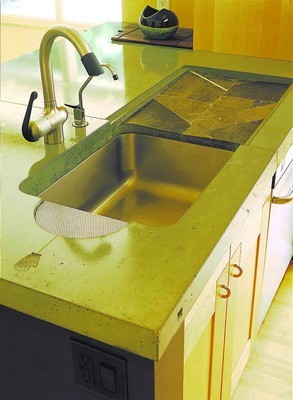Hard to Beat
Thinking of making improvements to your kitchen? There's a super material out in the marketplace for your countertops. It's extremely durable and versatile, can be shaped and colored to meet specific needs, costs less per square foot than most other materials and it's green. It's also the same material used to create sidewalks and patios -- sort of.
Let me introduce you to concrete.
As a kitchen countertop, concrete can be polished to a bright shine that rivals imported granite and marble, is durable enough to withstand the wear and tear that comes from preparing meals and can be poured into any shape along with integrating special features such as drain boards and trivets.
"The sky's the limit. It's a chance to change the dynamics of the kitchen by doing something creative," said Fu-Tung Cheng, a pioneer in the use of concrete for countertops and the author of three books on the subject.
Although the base Sackrete is the same material used in construction projects, Cheng said the type used for countertops features cement particles that have been finely processed so it can achieve that finished look when dry and hardened.
Cheng said he also appreciates the green element of concrete countertops. Instead of having to quarry stone overseas, transport it to the United States and then to several locations to have it fabricated before it is installed in a person's home, concrete usually comes from quarries less than 200 miles from the home.
"It's got a low carbon footprint, high creativity and low cost."
And it adds a timeless element to a home's décor.
Cheng said he challenges people to look at pictures of his work from the past 25 years and date them.
"Some of those they think are from yesterday are from 25 years ago and those they think are from 25 years ago were done two months ago," he said. "It's difficult to pin down what era they are from because they fuse so nicely with other materials."
"From my point of view, it is a timeless material that can go with any style from French country to a fancy, modern super-sleek house on the beach," said James DeWulfe of DeWulfe Concrete in Los Angeles.
Although the countertops can be made by anyone with just a little practice (Cheng's third book, "Concrete Countertops Made Simple," is a do-it-yourself guide with an accompanying DVD), Cheng teaches professionals how to make them a designer element of the home. In fact, for most of the past 25 years, Cheng has used concrete countertops as a high-end product at his design firm.
"It started for me always as a high-end product," he said. "I wrote my first book in 2002 because I was becoming alarmed at the direction countertops were going in. They were being made as rustic, pour-in-place sidewalks up three feet."
Cheng, who has been inducted into the National Kitchen and Bath Association's Hall of Fame for his design work, and his followers use molds that allow them to incorporate designer features and inlays, as well as polish the concrete so that it shines.
DeWulfe agrees that making concrete countertops is an art.
As a liquid, concrete can be made thick or runny and manipulated any way the artist desires. It can be poured into forms, colored and textured. When poured onto a piece of glass, it mimics the glass, he said.
The former investment banker stumbled across concrete as a medium about six years ago. His first piece was an ashtray.
"I loved it," he said. "It's a really fun to work with. You can do anything with it."
Now, in addition to countertops, DeWulfe's company makes indoor and outdoor furniture, fireplace surrounds and vanities.
"I think it will be the wave of the future, said Rob Morley of Color Crete in Henderson, which specializes in concrete countertops.
Morley first saw Cheng's work at a World of Concrete exhibit about five years ago and said he was so impressed with it that he decided to try it himself.
His first effort was a vanity top for his children's bathroom. As neighbors saw him working in his garage, making the mold and polishing the countertop, interest grew until he decided to make them professionally.
Before expanding his repertoire to include countertops, Morley had worked with concrete pouring curbs, gutters and sidewalks before evolving into slabs, architectural work and tilt-up buildings.
Cheng decided to use concrete for countertops the first time out of necessity in 1971, a time that ironically was also in the middle of a recession. "I had more time than money and was staring at the terrible kitchen of the home I was living in."
He decided to fix up the house, using recycled materials wherever he could. When it came time to replace the kitchen countertops, Cheng said he couldn't afford Formica.
In addition to his design work, Cheng has started a company that offers the additives and supplies needed to make concrete suitable for countertop use. Cheng calls it a small little roux that can be added to the ubiquitous flour found in every home-improvement center.




























